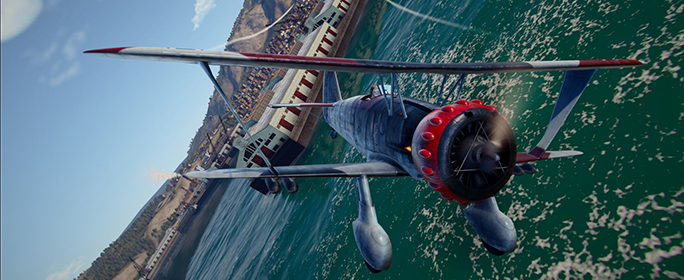-
![LANG-CODE-KEY]() LANG_NAME_KEY
LANG_NAME_KEY

The Henschel Hs 123 is a good example of a well designed and constructed aircraft that is capable of effectively serving for many years, and there are many situations in which even more advanced machines cannot surpass it.
The Hs 123 was one of the first designs created by the Henschel company, which initially specialized in railroad locomotives. Their first aircraft manufacturing facility was located in hangars rented from a railroad car manufacturer in the outskirts of Berlin. Henschel started with a Hs 121 trainer aircraft and Hs 122 multirole fighter, but the Hs 123 dive bomber became the first really successful model of the manufacturer.
In 1933, RLM (German aviation ministry) ordered designs for a transition model of a dive bomber and attack aircraft. The order was placed with the Henschel and Fieseler companies, direct competitors at the time. The resulting aircraft was supposed to fill the role of a close air support machine for frontline operations until the main model for this purpose, the legendary Ju 87 Stuka, was finished and deployed. By early 1935, both manufacturers had their prototypes ready and the Hs123V1 turned out to be much better than the Fi 98. Naturally, the RLM chose Henschel’s design for production.

The Hs 123 was a full-metal sesquiplane (the lower wing was much smaller than the upper one). The first prototype was powered by the BMW 132A-3 radial air-cooled engine, the second used a licensed copy of the more powerful Wright Cyclone motor, while the production aircraft had BMW 132Dc engines that provided 880 hp thrust. All these engines were radial and used air cooling — a detail that turned out to be crucial later on. The Hs 123 could dive very steeply at an angle of up to 80 degrees, becoming virtually invincible to small caliber fire, and was capable of bombing very accurately. The armament consisted of two 7.9 mm MG 17 machineguns, the bomb load included 4 wing-mounted 50 kg SC50 bombs and one 250 kg SC250 bomb mounted under the fuselage. Its fully metallic construction made the aircraft highly resilient and capable of withstanding outstanding punishment from small arms and AA fire, the pilot was additionally protected by a layer of armor around the seat and an armored headrest.
Around 250 Hs 123s were produced overall. Initially, the machine didn’t gain much recognition because, prior to World War II, Germany did not conduct operations where close air support would be required. At the same time in Spain, during the Civil War, the Hs 123 turned out to be invaluable. The first 5 machines were sent there for trials and assumed the role of tactical bombers. Their ability to accurately deliver their bomb load coupled with their great survivability made them very effective as a means to support ground troops on the frontline. Eventually, general Franco purchased all five of the test aircraft and ordered 11 more aircraft from Henschel, and one of those machines even managed to survive till the end of WWII. Interestingly, the Spanish called the Hs 123’s Angelito, “a little angel”.

True appreciation for the Hs 123 was shown at the beginning of World War II. The aircraft proved capable of operating in terrible conditions, taking off and landing on the waterlogged fields. Great durability and ease of service resulted in many more combat flights than regiments equipped with newer and more advanced aircraft. For example, the Bf 109E-7/B fighter-bomber that operated on the same fronts at the same time was much more demanding in terms of airfields, especially when taxiing and taking off with a bomb load. Its inline water-cooled engine was prone to damage from small arms fire. For tactical purposes, namely close air support of advancing troops during Blitzkrieg, such as deterring enemy counter-attacks and destroying designated targets, the Hs 123 was perfect. There was one more aspect that provided additional value to utilizing the aircraft on the frontlines: when diving, the pilot could adjust the engine RPM so that its sound would resemble the staccato of a machine gun, further intimidating enemy troops.
Over the course of WWII, the Hs 123 took part in nearly every major offensive, starting from Poland and France, redeploying to the Netherlands and the Balkans and then transferring to the Eastern Front in Operation Barbarossa. The Hs 123 participated in engagements around Leningrad, Moscow, over Crimea, Kharkiv, and Kursk. The damaged and destroyed machines were replenished by pulling aircraft from flight schools and derelict aircraft storage dumps all over Germany. In 1943, Wolfram von Richthofen even probed Henschel to resume production of the Hs 123, but the manufacturer had dismantled the production lines and tools back in 1940 when the machine was discontinued. The aircraft was phased out of combat service only in 1944 and replaced by the Ju 87, which was initially supposed to happen in 1937.

The Henschel Hs 123 in World of Warplanes is the first production variant, the Hs 123A-1. It is armed with two 7.9 mm machine guns and four 50 kg bombs. While it is not among the most maneuverable biplanes of its tier, the Hs 123’s flight characteristics make it quite capable of dogfighting even against fighters. After dropping its bomb load, the machine can freely engage in aerial combat where its high durability will even out the chances of winning against more maneuverable, but less survivable enemies. Another good trait is that it does not require any special skillset from the player and can be efficient and pleasing to fly for both new players and veterans.